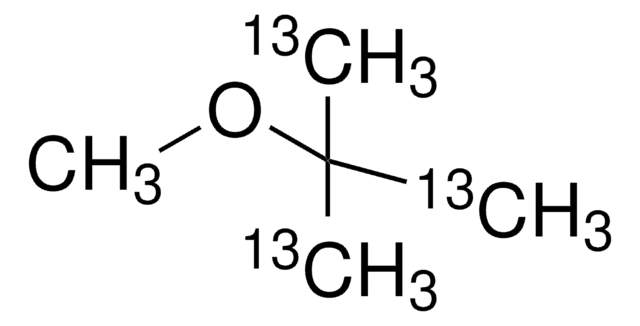50126
ter-butil metil etere
suitable for HPLC, ≥99.8% (GC)
Sinonimo/i:
MTBE, Metil ter-butil etere
About This Item
Prodotti consigliati
Grado
HPLC grade
Densità del vapore
3.1 (vs air)
Saggio
≥99.8% (GC)
Stato
liquid
Temp. autoaccensione
705 °F
Durata
limited shelf life, expiry date on the label
Limite di esplosione
15.1 %
tecniche
HPLC: suitable
Impurezze
≤0.05% water
Residuo dopo evaporazione
≤0.001%
Indice di rifrazione
n20/D 1.369 (lit.)
n20/D 1.369
P. ebollizione
55-56 °C (lit.)
Densità
0.74 g/mL at 25 °C (lit.)
λ
H2O reference
Assorbanza UV
λ: 220 nm Amax: 1.0
λ: 250 nm Amax: 0.1
λ: 280 nm Amax: 0.01
applicazioni
food and beverages
Stringa SMILE
COC(C)(C)C
InChI
1S/C5H12O/c1-5(2,3)6-4/h1-4H3
BZLVMXJERCGZMT-UHFFFAOYSA-N
Cerchi prodotti simili? Visita Guida al confronto tra prodotti
Avvertenze
Danger
Indicazioni di pericolo
Consigli di prudenza
Classi di pericolo
Flam. Liq. 2 - Skin Irrit. 2
Codice della classe di stoccaggio
3 - Flammable liquids
Classe di pericolosità dell'acqua (WGK)
WGK 1
Punto d’infiammabilità (°F)
-18.4 °F - closed cup
Punto d’infiammabilità (°C)
-28 °C - closed cup
Scegli una delle versioni più recenti:
Certificati d'analisi (COA)
It looks like we've run into a problem, but you can still download Certificates of Analysis from our Documenti section.
Se ti serve aiuto, non esitare a contattarci Servizio Clienti
Possiedi già questo prodotto?
I documenti relativi ai prodotti acquistati recentemente sono disponibili nell’Archivio dei documenti.
Il team dei nostri ricercatori vanta grande esperienza in tutte le aree della ricerca quali Life Science, scienza dei materiali, sintesi chimica, cromatografia, discipline analitiche, ecc..
Contatta l'Assistenza Tecnica.






